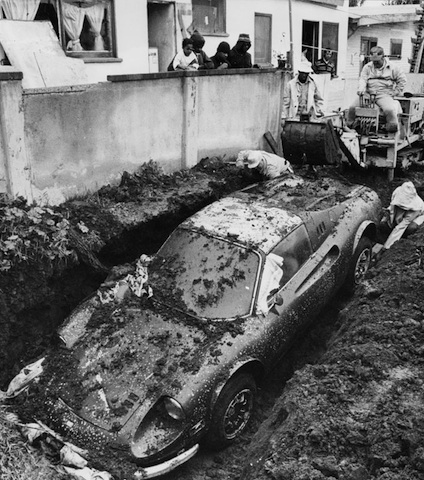
In the late 1970s, a group of kids were digging in the yard of a house in Los Angeles when they struck something that looked like the roof of a car.
They flagged down a police patrol and a team of cops and men with a digger and shovels soon after uncovered a metallic green Ferrari Dino 246 GTS.
On February 8, 1978, the Los Angeles Times reported that the car appeared to be in “surprisingly good condition.”
Ferrari fans would later note the Dino had been fitted with the optional Campagnolo wheels and Daytona seats.
Investigators found that the car – numberplate 832 LJQ – had been bought in Los Angeles in October, 1974, but reported stolen two months later. It was still on the police stolen list.
How did it end up buried in suburban LA? Long-time residents in the street knew nothing about it. Whoever buried it had obviously expected to claim it later – they’d wrapped it in plastic sheets and rugs.
The car was returned to an insurance company and the case of the buried Ferrari soon fizzled out.
Eight years later, in 1986, AutoWeek reporter Greg Sharp picked up the trail and tale of the Dino.
It was first ordered in 1974 by a dealer in Reno, Nevada, then shipped to one in downtown San Francisco before being shipped again 700km south to Hollywood Sports Cars, one of America’s 46 Ferrari dealers.
The Hollywood outlet was famous for sales to celebrities like Frank Sinatra, Perry Como, Sammy Davis Jr, Pat Boone, William Holden, Jayne Mansfield, Zsa Zsa Gabor, and Suzanne Pleshette.
The Dino didn’t have to wait long for a buyer – an LA plumber bought it in October 1974 as a birthday present for his wife.
She drove it for 800km before it was stolen outside the famous Brown Derby restaurant on the night of December 7, 1974 – the couple’s wedding anniversary.
Police suspected insurance fraud (3000 cars a month were being stolen in LA back then) but later declared it officially missing and insurers paid out in 1975.
Fast forward to 1978 when the resurrection of the Dino attracted all sorts of interest. But the LA Times’ opinion that it was in “surprisingly good” condition was way off.
Sharp wrote that the Dino’s 21 layers of paint were freckled with white pox. Rust had eaten holes in the Pininfarina body and interior. He said “dumb ass” thieves stuffed towels between the windows but neglected to roll up the windows all the way.
Erosion had wasted the wheels and chewed the camshaft covers. Both twin exhausts were plugged solid with dirt. Dragging the Dino out of the ground had further damaged it, gouging the roof and smashing the windscreen.
The Dino was beyond repair, so the insurance company put it on public display and invited bids. The plan backfired: the car was returned to the insurers missing almost everything not bolted down, including the oil dip stick.
Later, a young LA mechanic bought it privately from the insurers and the trail of the car again fizzled out – until it cropped up on the California Department of Motor Vehicles register with the personal number plate DUGUP.
Soon after it went into hiding again. Now, more than 35 years after it was found buried, it is still in hiding.
